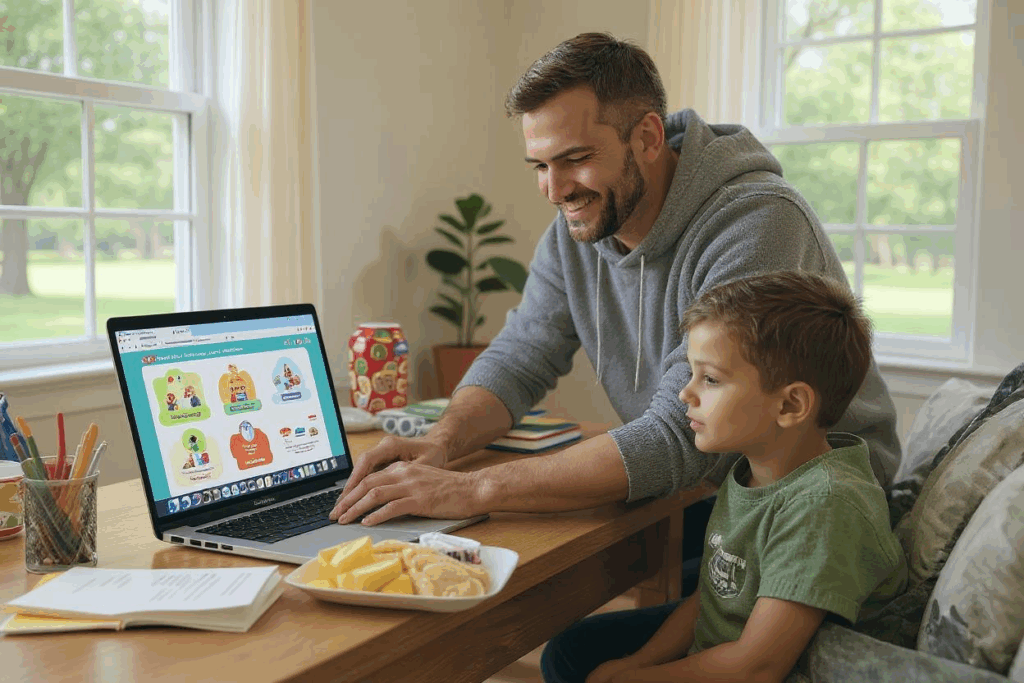If you’re wondering how parents can support online learning without burning out, you’re not alone. Many families are still adjusting to learning from home – and that doesn’t mean recreating a classroom in your kitchen. The key is to create calm, clear routines that support learning and protect family well-being.
A recent study found that when parents support routines and emotional regulation—not academics alone—children are more engaged and less stressed during online learning (Bhamani et al., 2020).

1. You Don’t Have to Be the Teacher
Let go of the pressure to be the perfect at-home educator. Your child doesn’t need you to recreate school. They need you to create steady rhythms that help them focus, reset, and stay connected to their learning community. The most powerful support comes through structure, encouragement, and emotional availability – not academic expertise.
2. Establish Routines that Reduce Stress
A strong start to the day can set the tone for everything that follows. Kids feel more grounded when they know what’s coming. Establish a consistent wake-up time, offer a quick breakfast, and keep screen-based lessons short and predictable. Rather than packing the day with back-to-back work blocks, allow natural breaks for movement and creative play.
Try This: Create a simple routine chart your child can follow on their own. Visual checklists work great for ages 5–8, while older kids (9–13) can co-create a daily plan they’re more likely to stick to.
Reflect: What time of day does your child seem most focused or energized?
3. Create Spaces that Support Learning
Learning at home works better when kids have a space that feels like theirs. It doesn’t have to be a full home office—just a quiet spot with good lighting, their materials within reach, and as few distractions as possible. Younger kids might benefit from a visual timer or a comfy chair. Tweens often appreciate noise-canceling headphones or a dry-erase calendar to manage their own assignments.
Try This: Invite your child to personalize their space with one object that brings them joy: a drawing, a plant, or a favorite pencil holder.
Reflect: How does your child act differently when learning in a calm, organized space?
4. Use Motivation that Actually Works
You don’t need gold stars to keep kids motivated. In fact, praise for effort often works better than praise for outcomes. Tell your child, “I noticed how you kept going even when that got tricky,” or, “You focused for ten whole minutes without a reminder.” Younger children respond to encouragement and short-term fun goals. Older students are more engaged when they understand why something matters to them.
Want to help your child handle challenges more calmly during learning time? Try these strategies from our blog, Raise Resilient Kids with These 5 Easy Habits.
Try This: Ask your child to explain something they learned that day, as if they were the teacher. Giving them the spotlight boosts both confidence and retention.
Reflect: What kind of recognition makes your child light up?
5. Learn to Balance Screen Time Wisely
Online learning adds up, and it’s okay to be concerned about screen fatigue. What matters most is making time each day to unplug, stretch, and engage in hands-on activities. For younger kids, a dance break or simple art project works wonders. Tweens might enjoy outdoor walks, journaling, or playing music.
The whole family can model healthy tech habits by taking shared screen breaks. For more age-specific tips on healthy screen habits, check out our guide: Screen Time Rules by Age: What Parents Should Know
Try This: Build a “Tech Break Hour” into your child’s routine – no screens, just rest and creativity.
Reflect: What does your child’s mood look like after time away from devices?
Frequently Asked Questions
Q: My child zones out or gets distracted—what can I do?
A: That’s completely normal. Try short bursts of work (10–20 minutes), use timers for focus, and give regular chances to reset.
Q: How involved should I be in their schoolwork?
A: Think of yourself as a coach. Check in, offer help when needed, and stay in the loop with their teacher—but don’t feel like you have to lead every lesson.
Q: What if I’m working during their school hours?
A: Predictable routines help here. A short check-in before and after school—even five minutes—can make your child feel supported and connected.
Support Learning Without the Pressure
Understanding how parents can support online learning doesn’t mean being perfect – it means being present, prepared, and patient. With thoughtful routines, personalized spaces, and built-in breaks, you can create an environment where your child thrives, and you feel more in control, too.
Parent Pathways Academy offers guided tools for parents, family check-ins, and easy daily tips to help you stay connected without the pressure to “do it all.”
Download the PPA app and get started today.
References
Bhamani, S., Makhdoom, A. Z., Bharuchi, V., Ali, N., Kaleem, S., & Ahmed, D. (2020). Home Learning in Times of COVID: Experiences of Parents. Journal of Education and Educational Development, 7(1), 9–26. https://files.eric.ed.gov/fulltext/EJ1259928.pdf
Knorr, C. (2020, August 11). Using Common Sense: 9 ways to motivate kids for online learning. Raising Arizona Kids. https://www.raisingarizonakids.com/2020/08/using-common-sense-9-ways-to-motivate-kids-for-online-learning/

